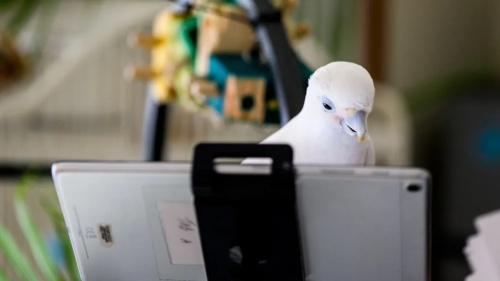The Rise of the "Animal Internet": How Dog Phones and Parrot Touchscreens Are Changing How Pets Communicate

Imagine your dog calling you while you're at work—not because you're calling home, but because it wants to go home. Or imagine a parrot excitedly shaking its screen to greet friends around the world. These scenarios, once the stuff of science fiction, are rapidly becoming a reality thanks to groundbreaking innovations known as the "Animal Internet."
This emerging field aims to connect humans and animals through digital technology—not just for entertainment, but to foster deeper understanding, empathy, and two-way communication. From dogs initiating video calls to birds chatting on touchscreens, technologies in the "Animal Internet" are challenging our preconceived notions about animal intelligence, emotions, and expression.
A New Digital Ecosystem for Animals
The term "Animal Internet" captures the growing field of animal-computer interaction (ACI) research—the study of how animals can meaningfully interact with technology. Traditionally, technology has been a tool for human convenience: feeding machines, tracking collars, and pet cams. But ACI offers a different perspective.
Rather than designing devices for animals, scientists are co-creating interfaces with them—testing how different species naturally use technology to express themselves. The idea is that communication shouldn't be imposed by humans but rather develop through the interactions animals choose.
This philosophy reflects a significant shift in how we view animals: no longer as passive companions, but as active communicators capable of expressing intent, curiosity, and emotional connection. In this digital age, pets are truly taking charge of their voices.
Calling Dogs: A Leap Forward in Cross-Species Connection
One of the most fascinating breakthroughs in this field is the ability for dogs to proactively communicate with their owners. Researchers have been experimenting with simple, motion-activated devices that allow dogs to "call" their owners by interacting with an object—typically a ball, cushion, or motion sensor connected to a video system.
Early testing has revealed surprising results. Many dogs repeatedly use the device, even without prompting, suggesting they understand its effects and enjoy the active contact. Some dogs appear to call when anxious, bored, or lonely, while others use it out of curiosity or play.
For animal behaviorists, this opens up a whole new avenue of inquiry: What motivates dogs to spontaneously communicate with humans? Is it emotional need, curiosity, or simply pattern learning? Whatever the answer, this behavior demonstrates agency—the ability of animals to act intentionally in a shared environment.
Beyond the novelty, these systems can significantly improve the well-being of pets who are kept alone for extended periods. Separation anxiety remains one of the most common behavioral issues in dogs, leading to stress-related behaviors such as barking, pacing, or destructive chewing. Dog-initiated communication channels can provide emotional comfort and a sense of connection—both of which contribute to calm and confidence while their owners are away.

Parrots and Touchscreens: A Digital Community in the Making
While dogs are exploring the world of video calls, birds—particularly parrots—are learning how to operate touchscreens. Parrots are highly social and intelligent creatures with rich emotional lives and an innate need for mental stimulation. In captivity, they often experience boredom and loneliness due to a lack of interaction with their peers.
Touchscreen systems designed specifically for parrots are helping to change this. Parrots can interact virtually with other birds through an intuitive, colorful interface, responding to pecks and touches. In experimental studies, many parrots actively and repeatedly used the screen to make sounds, nods, and preen their feathers through the camera.
The most striking observation was the formation of clear social bonds. Birds began to recognize familiar companions and choose to interact with specific individuals, demonstrating memory, preference, and even friendship.
This technology not only provides entertainment but also enriches lives. Even virtual social contact can reduce behavioral problems such as feather plucking and repetitive pacing in parrots. Furthermore, it gives parrots autonomy in social choices, allowing them to decide when and with whom they interact.
From Buttons to Meaning: Expanding Pet Vocabulary
The "animal internet" is not limited to visual or action-based communication. Another area of research focuses on enabling animals to "speak" using vocal buttons or symbols. Each button emits a different word or tone—representing concepts such as "play," "food," "outdoors," and even emotions such as "happy."
Over time, many pets learn to combine these buttons in consistent patterns, suggesting a rudimentary form of language. For example, a dog might press "want," "go," and "you"—forming a sequence that reflects both intent and context.
Critics have suggested that these patterns might simply be the result of reflexes or coincidence. However, longitudinal studies have documented spontaneous, contextually appropriate use—even novel combinations that appear to represent creative expression.
Whether or not this qualifies as "language" in the human sense, the system undoubtedly provides pets with greater behavioral control and cognitive stimulation. It offers them a new way to express needs, preferences, and even emotions—transforming everyday interactions into richer conversations.
The Role of Artificial Intelligence in Pet Communication
Artificial intelligence (AI) is rapidly advancing these developments. Modern AI systems can analyze complex data from sensors, microphones, and cameras to interpret pet behavior in real time.
For example, wearable devices equipped with accelerometers and sound sensors can track a pet's posture, movements, and vocalizations. Combined with AI models trained on extensive animal behavior datasets, these systems can infer whether an animal is relaxed, anxious, playful, or distressed.
This real-time insight helps humans respond more appropriately to their pets' needs, fostering empathy and improving their well-being. Imagine getting a subtle notification on your phone: "Your cat is showing signs of stress—we recommend taking him out for a playdate soon" or "Your dog's energy level is unusually low today."
As AI becomes more sophisticated, it may even begin to discern individual emotional nuances or contextual meaning in vocalizations—much like human speech recognition systems.
The Promise of Cross-Species Understanding
The implications of these developments extend far beyond pets. Some researchers envision a future where cross-species communication networks connect humans with a wide variety of animals—from whales and dolphins to elephants and birds.
Efforts are already underway to use machine learning to decipher animal communication on a larger scale. By analyzing vast libraries of animal sounds and body language, scientists hope to map consistent patterns that correspond to specific meanings or emotions.
If successful, these projects could revolutionize animal conservation, enabling humans to better understand distress calls, mating calls, or territorial warnings. Farmers could use these systems to more accurately monitor the well-being of their livestock, while wildlife sanctuaries could detect early signs of stress or habitat destruction.
In this vision of the future, the "Internet of Animals" isn't just pet technology; it's a global empathy network—helping humans listen more closely to the many voices of nature.
Reimagining the Human-Animal Relationship
At its core, the "Internet of Animals" challenges one of the deepest divides in human thinking: the boundary between human and nonhuman intelligence. For centuries, we've measured cognitive abilities based on anthropocentric metrics—language, tool use, problem-solving—while often overlooking the complex emotional and social worlds of other species.
Digital communication technologies are gradually breaking down this divide. When a dog barks or a parrot chooses a picture to greet a friend, they aren't imitating human behavior—they're expressing autonomy through a medium humans can understand.
This has the potential to transform daily life. Future homes may include shared communication hubs where pets can send messages to their owners, request specific activities, and even coordinate with automated systems like feeders or climate controls. Veterinary visits might include digital logs of pet-initiated communications, providing insights into pain, discomfort, or emotional shifts.
More profoundly, the "Internet of Animals" forces us to rethink companionship itself. Even the simplest exchanges can foster empathy. When pets begin to directly share their emotions and intentions, the relationship between people and animals may evolve from caregiving to true conversation.



